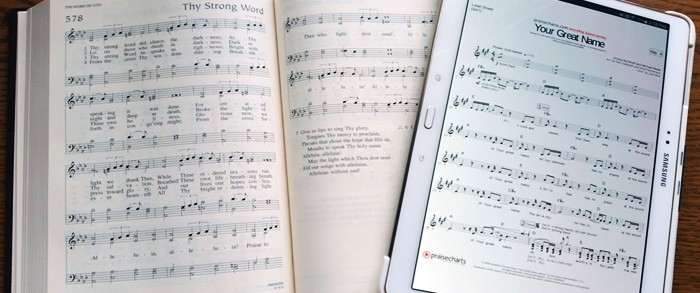by Matthew Starner
I’ll be honest. I stole curated that title from a post over at The Worship Community. The post itself was fine, but the title put into words what I have been feeling for a long time: the polarity between “traditional” and “contemporary” is tired and unnecessary.
Before I get too far into this though, what I want to speak to is not style but content. You can take the same lyrics and tune and accompany it with an organ, a worship team, or sing it acapella. There are many possible styles for the same piece. Instead, what I want to focus on is content.
You’re Not Too Cool For Traditional…
Hymns have played a role in worship since the earliest days of the church, and especially since the Reformation. Martin Luther helped to bring hymns to greater prominence when he encouraged the congregation to actually participate. In the time before the Reformation, people would attend the service and the choir or priest would sing – often in Latin, which no one understood. But when hymns were translated into the language of the people and they were encouraged to sing, everything changed.
Hymns are characterized by their simple form, their [general] singability, and theological depth. In terms of form, the vast majority of all hymns are “strophic,” meaning every verse has the same melody. This makes them easy to learn and remember. They also are usually singable by the average person. There certainly are hymns that are challenging to sing, but for the most part, the rhythm and melody are kept simple. The biggest thing that hymns have is their depth of theological content. Hymns have captured in beautiful and poetic language the truths of Scripture. There’s a reason that so many of them have lasted for hundreds of years: they help us understand the faith in timeless ways.
Those hymns are a gift given to us by our spiritual forefathers. Yes, there are weak hymns that get replaced by stronger ones. Yes, there are some that are better suited to your theological or denominational position than others. But to simply throw out all hymns is to say that these gifts from those who have gone before us are worthless.
So no, you’re not too cool for traditional. You need the depth of content that hymns bring to your worship experience.
…and You’re Not too Mature For Contemporary
On the other side of the spectrum are modern worship songs. These songs usually reflect the popular music styles of today in their form and lyrical style. Modern worship songs (I loath the term “contemporary songs”) are often more complicated in form. There’s usually some combination of a verse, chorus, and often a bridge. There may be an instrumental break or a solo section. These pieces are placed together to create an interesting and more complex piece which echos the music most of us hear every day. This practice is nothing new; traditional church music has often been reflective of the popular music of its day.
The thing that modern songs bring with them is a different lyrical style. Rather than the intricately crafted prose found in hymns, modern worship songs are of a more devotional, personal nature. This was often used as a point of attack in the days of the worship wars. “Contemporary songs are all fluff. They’re too me-centered.” But what modern worship songs help us to do is bring the truths of God to a personal level.
If hymns communicate God’s truth, modern worship songs help us apply that truth. They both have a role to play in worship and help us grow as disciples of Jesus. There’s a place for both of them in worship.
This certainly isn’t anything new. After all, for the last several years some of the major Christian worship artists have been producing some great songs based on very traditional hymns or texts: Chris Tomlin’s Crown Him, Hillsong’s Cornerstone and This I Believe, Casting Crown’s Glorious Day, and others have showed a renewed interest in these classic songs of the faith.
A Word About Style
Speaking only about the songs used in worship, I think it’s important to find ways to appropriately bring the old and new together in your context.
If you’re in a traditional church bringing in a worship band with drums and electric guitars when the normal accompaniment is piano or organ is going to go over like a lead balloon. You’ve got a style that has been established – work within that style. You’d be surprised how well a modern worship song would go over with a simple piano accompaniment. Or try an acoustic guitar with a soft stop on the organ playing simple chords (a light flute or celeste stop works great as a pad!). Try featuring a song as a special piece or anthem as a solo or duet – even sung by a choir! Don’t overwhelm your congregation and with a sudden influx of tons of modern songs. Work one in occasionally, especially if it fits with the message or theme for the day. (You are talking with your pastor in all this preparation, right?)
If you’re in a modern church, going from a driving rock beat to a sudden 4 part harmony hymn is going to leave everyone scratching their head wondering when they stepped into a time machine. The key here is to arrange the hymns to fit your style. As I mentioned above, there are many that have already successfully been arranged this way by people who know what they’re doing. But don’t let that stop you from trying your hand at it! One thing you’ll notice is that hymns have way more chord changes than modern songs. Eliminate the ones that you can and give it a feel that fits the text. Or get really daring and set the lyrics to a new melody or add a simple chorus!
You’re not too cool for traditional. You’re not too mature for contemporary. Hymns bring depth, modern songs bring devotion. Push yourself to experiment and add a new dimension to your worship!
Matthew Starner is pastor of Journey of Faith Church in Grand Rapids, Michigan, where they help people take their next step on their journey with Jesus. Visit his website at matthewstarner.com




2 Comments. Leave new
As a believer AND as a pastor I am very much about the content and less so about style. The musical form should enhance (not interfere) with the message. The small (and mission) churches that I have served are usually limited musically due to the skills of our instrumentalists. Having our 80+ year old pianist play “Shine, Jesus, Shine” was a disaster! At our current church we have gone months without piano, organ, any accompaniment. So singing accapella depended on strong voices and familiar songs. I would gladly entertain other styles, IF we had the musician.
I am 63 and have over 35 years’ experience in playing a keyboard with contemporary christian music bands. It certainly is my “happy place” as I love to improvise and play off chord charts. I had to chuckle at your “Shine Jesus shine” comment. First of all that song is SO old its not contemporary anymore, and most church musicians refuse to play that song — its that irritating. Whether you are 60 or 80, your musical style HAS to change with the times, always be “young” thinking and listening and learning to all musicial styles. Never play Shine Jesus Shine, and if you must, NEVER in a polka style. 🙂